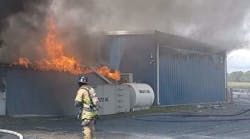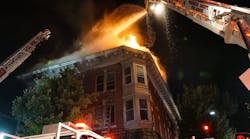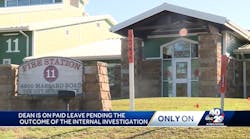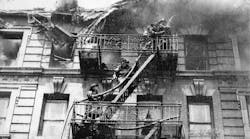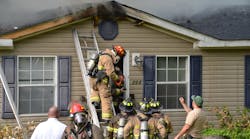On Saturday morning, June 17, I set out on a five-day cross-country trip to Sedona, AZ with my oldest brother David, who had moved there two years earlier. It was a much needed vacation for me and a necessary trip for my brother to retrieve some things from home in Buffalo, NY.
On Sunday morning, the Brins Mesa Fire in Oak Creek Canyon started one mile north of Sedona. We watched the fire's progress on the national news as we made overnight stops in Abilene, KS; Colorado Springs and Durango, CO.
By the time we arrived in Arizona on Wednesday, June 21, the fire had already burned 1,500 acres of the Cocanino National Forest and was only five-percent contained. More than 400 firefighters were already committed to the effort.
It was the first thing we saw as we came down Interstate 17 out of Flagstaff, requiring us to take an alternate route because Route 89A was closed through Oak Creek Canyon. As we made our way north on Route 179, we could see the smoke billowing behind the silhouette of the famous Bell Rock outside of the Village of Oak Creek.
I've been to a lot of fires in my 25 years as a firefighter but this was nothing like anything I had ever seen before. I was definitely out of my element.
Naturally, my curiosity was peaked and we had to go in for a closer look. Near dusk, we drove into West Sedona to Seven Canyons Resort where my brother works. We were able to look straight up at Brins Mesa where the fire originated on June 18, reportedly due to camp fire a transient failed to extinguish before moving on.
We were only looking at one side of the fire, a small chunk, but the flames were clearly visible, spreading across the mountain, sometimes in large clusters and elsewhere scattered with smaller spot and drop fires from the mesa above.
The fire had caused the evacuation of 400 residents of the canyon and threatened more. If given the opportunity to jump Route 89A and Oak Creek, millions of dollars in business and residential property and thousands of lives would hang in the balance.
I've done some reading and watching of wildfires on the web and through normal news sources but I've never experienced anything of this magnitude close up. First of all, the "work environment" for the firefighters was unlike anything I've experienced. The rugged terrain is treacherous at best in some spots and at the very least, slow and laborious across the mountainside. Thick pines and red rock are stacked between the firefighters and their escape routes.
We revisited Seven Canyons the following afternoon to witness one of the most spectacular firefighting efforts I'd ever seen in my life.
Three Sikorsky CH-54 Skycranes were using the resort's golf course ponds to draw water for the fire fight. Like huge flying pre-historic birds swooping down, the Skycranes dropped their 28-foot-long suction hoses into the ponds, sucking up some 2,850 gallons in about 30-45 seconds.
These monster choppers would drop down over the golf course's water hazard, drop their line in, hover briefly just above the pond surface, pick up their load and lift off while water was still spraying from the end of the hose as the cap was automatically closed from the cockpit.
They would then fly up to the Mesa and rain down their load on the raging fire. Each helo would repeat this sequence every four minutes or so. I was less than a hundred feet away when I witnessed this element of the fire fight.
The deliberately orchestrated timing of the pick-ups and drops had the rhythm of a helicopter ride at an amusement park, with the whole ride stopping occasionally to drop passengers off and pick up new ones. As needed, the choppers would head off to the helibase at the Sedona Airport on top of a nearby plateau to refuel or receive maintenance.
I spoke with a few smokejumpers from Oregon who were overseeing the helispot set up at the resort. One of them indicated that they were not accustomed to fighting such a large fire. They usually repelled into the fire early on in an effort to keep the fire from spreading.
He suspected that, given the size and magnitude of the fire, and the rugged terrain and the high temperatures, the firefighters engaged on the mountaintop were probably having a rough go of it - an understatement I'm sure. (I've politely paraphrased the words he used to describe their working conditions.)
The following evening we went to the restaurant at the airport and saw the Skycranes land and take off, using extreme care not to damage their suction hoses. We also saw large helos carrying "bambi buckets" - another method of drowning the fire.
Later that evening we drove up to the vista on famous Schnebly Hill at an altitude of 5,000-plus feet. The trip to the vista is not for the faint of heart and a J eep is recommended as after the first few hundred feet, the pavement disappears into some of the roughest red rock you'll ever see. There are plenty of blind curves and many passages along the way are only maneuverable by one vehicle at a time as the road zigzags up the 2,000-foot ascent stretched over 13 miles.
We had plenty of company as from there we saw another side of the fire as it flared up brilliantly in the pitch-black night sky.
By 10 A.M. on Thursday, 3,256 acres of national forest had burned with only seven percent containment. More than 690 firefighters were already on the job; according to the local newspaper, the Sedona Red Rock News. It continued to be the number one priority fire in the nation.
My visit to the airport and the news clippings brought things together for me in relationship to this fire.
Prior to my vacation, I'd been teaching a lot of ICS-100, ICS-200 and NIMS-700 incident command system courses. We talk and teach about ICS facilities like bases, camps, helibases and helispots - but don't have a lot of real life application to back it up with, not having any experience with fires of this size, nature and magnitude.
It was at the airport that I saw the helibase sign and a map on the front page of Friday's Red Rock News outlined the camp and helispot locations. I saw firsthand the camps they had set up on the football field of the Sedona Red Rock High School where the firefighters slept in two-man tents. And, I saw the helo ops up close and personal. I'm trained and experienced in the various aspects of incident command, but this really put things into perspective for me.
The local newspaper told how the fire was now under control of a Type 1 Incident Management Team and Fire Crews and it explained the importance, capabilities and value of each.
By the end of day on Friday, containment had increased to 15 percent according to the local cable public access channel, but 3,977 acres had burned and the estimated cost of the firefighting operation was already $2,225,000 - all due to human error. An $11,000 reward was posted for information leading to the arrest and conviction of the parties involved.
Hotshot crews made up half of the personnel involved in the firefight.
On Saturday it was reported that the fire was 25-percent contained but they were far from out of the woods, pun intended.
We attended an outdoor concert in Uptown Sedona (remind you, I was supposed to be on vacation) and I was impressed and moved by the display of gratitude and admiration for the firefighters.
Everyone lined the streets, cheering and waving as the firefighters came up out of the canyon around 8 P.M. in a parade of wild land firefighting and rescue vehicles. The band, "Outright Jones," even posted a sign in front of their drummer that said it all: "Thank You Firefighters!"
By Sunday, the wind had kicked up and more than 700 firefighters were involved in the fight. More than 4,200 acres had burned and the operation had already cost $4,500,000 dollars.
I took a ride to West Sedona to see if I could get close to the ICP-Incident Command Post. I was looking for the inside scoop on the massive organization that was running this enormous operation, and I found it.
To make a long story short, I ended up spending about three hours in the command post and gained a wealth of invaluable knowledge and a life experience that I'll share in a future article.
All in all, I gained a new level of respect for what our western brothers and sisters endure and accomplish during wildfire season and I was treated to a unique opportunity to witness firsthand the effectiveness of the National Incident Management System.
The last crew I saw return to the camp on Sunday night told the whole story on their filthy, weary faces.
The good news is that by the time I left on Monday morning, the incident commander reported that the fire was 50-percent contained and hoped for 100-percent containment by Wednesday, June 28.
But, I'm sure the work doesn't end there, perhaps just the publicity and curiosity. In fact, soon they would start making plans for the BAER team to evaluate the damage. BAER stands for Burned Area Emergency Rehabilitation and deals with getting the forest back to its pre-fire state.
The bad news was that another fire had just closed down the Grand Canyon National Park and people were trapped between the fire's containment lines.
By then I was safely back home, enjoying the seemingly "routine" alarms and incidents we experience in the northeast and began monitoring local deployments to the flooded areas in downstate New York, a situation at the other end of the country - and certainly at the other end of the spectrum from a wild fire in Sedona, AZ.
We only wish we could send them some of our flood waters.
Following are some informative web sites about this fire and the area it has affected.
- Southwest Coordination Center
- Wildfire Incident Information
- Cocanino National Forest
- Firewise
- Wildland Firefighters Foundation
- Sedona Arizona
- Arizona Disaster Call Center
- Friends of the Forest
- Sedona Red Rock News
